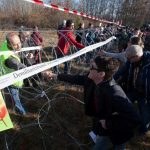Slovenian Minister Karl Erjavec defended the decision of his government to close the border to migrants.
The risk of a new wave of migrants on the so-called Balkan route and the possible return to Europe of foreign fighters from Syria are reasons for not removing the wire fence on the border with Croatia, said on Sunday Slovenian Foreign Minister Karl Erjavec, reports Index.hr on January 29, 2017.
“The so-called Islamic State will sooner or later be defeated, but this means that the foreign fighters in its army, and most of them have come from Europe, will start returning. If we do not establish adequate control mechanisms, then bad things will happen”, said Erjavec. He added that it is estimated that there might be as many as a thousand fighters from the Balkans in ISIS.
According to Erjavec, the main problem is the absence of a common migration policy in the European Union, which during the first migration wave underestimated that the instability of the Middle East and Africa would persist. For this reason, some countries, first Hungary, then Austria, and now Slovenia, have begun to act independently in order to protect themselves from a immigrant wave that would destabilize them.
The possibility that the agreement between the European Union and Turkey on migrants might collapse, as well as prolonged unstable situation in the European context, have forced the Slovenian government to amend its law on foreigners. The new law now makes it possible to stop illegal immigration at the border, and therefore it is still not time to remove “technical barriers” on the border with Croatia, said Erjavec.
“We can discuss human rights in theory, but I assure you – if 50,000 refugees were to come to Slovenia, their human rights would be much more vulnerable than if they stayed at home”, said Erjavec, defending the possible closure of the border in case of a new migrant crisis.
To illustrate the difficulties which refugees and migrants can experience if they are “stuck” on the route to Central Europe, Erjavec pointed out a very serious situation with about 7,000 refugees who are currently in Serbia.








